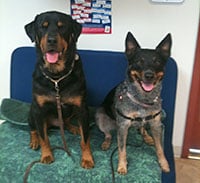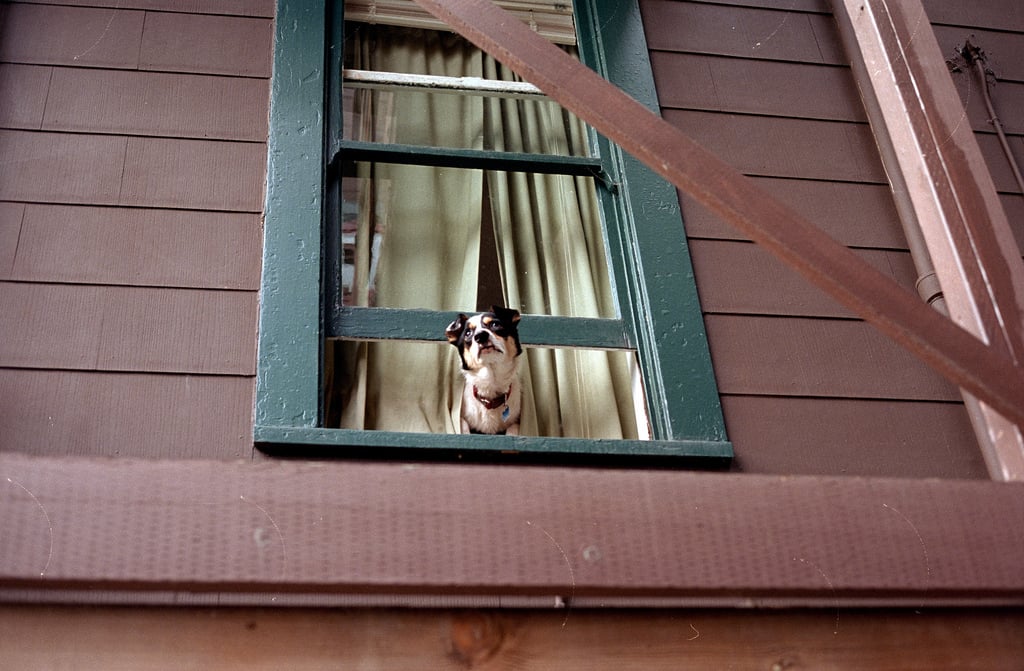- This post contains affiliate links. Read more here.
Eleasha Gall knows a thing or two about transitioning dogs to flat life. Gall, an animal behaviourist and dog trainer, moved with Gunner, a Rottweiler and Monster, an Australian cattle dog, from a 14-hectare (35-acre) farm to a 46-square-metre flat.

Gunner and Monster/Eleasha Gall
Owners accustomed to simply letting dogs out into a fenced garden or piece of land might quail at the thought of confining their rambunctious beasts to an unfamiliar small space. Will they bark at every noise, lunge at the neighbours, or become bored and depressed?
Gall’s experience as a trainer paved the way for her successful move, but anyone willing to put in the work can take advantage of the advice of Gall and other experts.
Harness big-dog energy in a tiny-dog environment
- Treat dispensing toys: “It’s probably the biggest and easiest thing that people can do,” Gall says. She always feeds her dogs from KONGs
; freezing them makes the food last even longer.
- Brain games and hidden treasures: Hide treats in the area of the apartment you want them to use. This makes the new environment very enriching, with fun things to do and find. “The mental stimulation will make your dog tired in a way that running them and just plain exercise won’t,” Gall says.
- Hire a dog walker and take your dog to day care once a week, or even into work if allowed.
- Head to the local dog park. Your dog will find exercise and you might find new friends to help out during your transition.
- Start a new exercise programme: Consider agility lessons, flyball or nosework, which is easy to do even in a small living space. Gall added FitPAWS, basically Pilates for pets, to their routine. “About 20 minutes on the FitPAWS and Monster is knocked out for three days,” she says. Their exercises include work on the peanut canine stability ball
and related equipment.
Teach your dog to be a good neighbour
Expect your dogs to be reactive, but set them up for success, Gall says. After all, if they’re used to a house, a flat can be startling. Suddenly the walls are making noise and there are people right outside the door!
- Put plants or blinds in windows to hide distractions and use a gate or pen to keep them away from the front door for the first week or two.
- Use sound machines
. Alternatively, music can block some of the noise and calm your anxious pet.
- Moving is a busy time but it is important to watch what your dog is going through, Gall says. If you hear a noise or see your dog perk up, say “good dog,” in a new exciting tone, before they bark then engage them with at least 30 seconds of reward such as ball-throwing, tug, scratches or treats.
- Teach them to hold a toy in their mouth: “Put a sock in it,” is the command that trainer and behavioural consultant Joan Mayer uses for her dog Poncho. Holding a toy gives a dog an alternative to barking, she says. Mayer allows one bark, then rewards the quiet behaviour.
- Prepare them ahead of time: Take your country dog for walks in a busier environment before you move. Download sound effects from the web and use them to train your pet in advance.
- Once in the apartment, try leaving the dog alone for few seconds at first, and build up from there.
To pee or not to pee
There’s no getting around the fact that taking your dog out to exercise and eliminate will be more work in a flat. Start with 20 or 30-minute morning and evening walks and, if possible, shorter jaunts during the day. Eventually, they’ll learn a routine.
The downside to using indoor elimination products like pee pads or turf is that your dog is not learning a schedule, and gets confused about where it’s ok to go. Pads feel too much like bedding, rugs, or clothing, too.
That being said, if you can’t get a pet walker and your dog is going to be alone all day, there are options.
- Artificial turf
: Gall has a friend who trained their dog to go on a square of artificial grass placed in the shower. Cleaning up was easy, and the dog knew that going there was ok, but only if the turf was down. Many flat residents put turf on their balconies. Make sure your balcony is safe for your dog before giving them access.
- Bring the outside in. There are several companies who now deliver patches of real grass. FreshPatch and Doggie Lawnare two of the most popular.
The bottom line
While smaller, less energetic breeds can have an easier transition to apartment life than larger dogs, there are exceptions. And many small breeds are predisposed to barking.
Realise that downsizing will take work for you and your pet, especially at first. “Plan ahead,” Mayer suggests on her blog. “Ask yourself ‘What is my final goal?’ and practice the skills your dogs need ahead of time to reach that.” And remember, Rover.com has plenty of dog sitters who offer dog boarding in your area so you can always ease you dog in by letting them spent some time in a house with a garden while you’re out.




